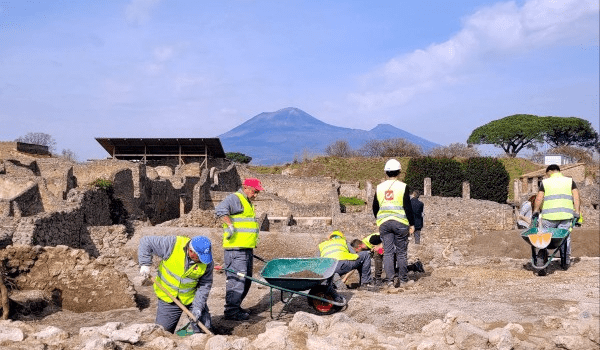POMPEII, NEW EXCAVATIONS HAVE BEGUN IN THE CENTRAL AREA OF THE SITE
The aim is to improve the conservation of the site, restructure the edge of the excavation and obtain new archaeological data
Excavations have resumed at Pompeii covering an extensive area of about 3,200 square metres, the equivalent of virtually an entire block (insula) of the ancient city which was buried by the eruption of Vesuvius in AD 79. The project is part of a broader approach which, originally developed during the Great Pompeii Project, aims to solve the problems of water seepage and the conservation of the edge of the excavation, in other words the boundary between the excavated area and the unexplored area of the ancient city. The unexcavated part of the site covers an area of about 15 hectares of blocks (insulae) and houses, buried beneath lapilli and ash, almost a third of the ancient settlement.
The approach adopted for the new excavations, situated in Insula 10 of Regio IX along Via di Nola, is therefore the same as the one used for the excavation of Regio V during the period 2018-2020 which, supervised by the former director Massimo Osanna, brought to light the House of Orion, the House with the Garden and the Themopolium (a snack shop or wine bar). The new excavations have improved the conservation and protection of the ancient structures of the site through reinforcement of the edges of the excavation, which have always been vulnerable due to the pressure of the soil on the ancient walls and rainwater run-off. The work has been undertaken by a wide range of professionals involved in archaeological work, including archaeologists, palaeoethnobotanists, volcanologists, numismatists, specialists in ancient topography, as well as architects, engineers and geologists, in order to gain as much information and data as possible from the excavations.
“Excavating at Pompeii is a huge responsibility”, states Gabriel Zuchtriegel, the site director. “Excavation is an unrepeatable event. What is excavated remains so forever. It is therefore necessary to devote great care to documenting and analysing each find together with all the stratigraphic relationships and to working out, right from the start, how to safeguard and restore what we find.”
The excavation is still in its early stages but the tops of the walls of the upper floors of the ancient buildings are already beginning to emerge, including a house, transformed during its final phases of occupation into a fullonica (laundry) and already excavated in about 1912, and a house with an oven and upper room. In the uppermost levels, archaeologists have identified a series of holes in the soil, possibly made in more recent times and presumably related to the agricultural use of the land, or possibly linked to the quarrying of lapilli which took place in the area in the modern era. Eighteenth- and nineteenth-century landscape paintings show how the plateau above the excavations was used for various agricultural activities between areas of woodland and rural buildings and greenhouses used by farmers, still in use until 2015. This historical landscape dates to the decades of the rediscovery of Pompei and the Park intends to enhance and illustrate it through another project designed to redevelop the green areas of the site and the surrounding territory. A selection procedure has been underway for the last few weeks aimed at finding a partner for the cultivation of the vineyards in the Park as part of a public-private partnership. The scheme will involve the expansion of cultivated areas and, in the future, the creation of olive groves, orchards and community vegetable garden plots.
“The scale of a catastrophe can also be evaluated by the possibility of forgetting it, of letting it slip into oblivion, observes Zuchtriegel. This landscape of farmland, woodland and pasture, which emerged in the centuries following the eruption that destroyed the ancient city, offers a degree of comfort with respect to the terrible tragedy of AD 79 that destroyed the entire city of Pompeii in two days. The memory of the tragedy gradually faded and life returned. So much so that, after the start of excavations in 1748, it took fifteen years to realise that the site being excavated was actually Pompeii and not Stabiae.”


